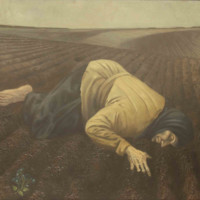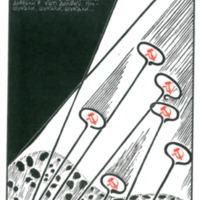Browse Exhibits (8 total)
Holodomor Art at the UHEC

The UHEC Patriarch Mstyslav Museum has in its permanent collection a number of artworks commemorating the genocidal artificial famine of 1932-33 known as the Holodomor.
These works range from the small and subtle to the graphic and monumental, and are by artists both well-known and not so well-known.
In addition to these works, the Museum has the full series of Mykola Bondarenko's Ukraine 1933: A Cookbook linocuts, which merit their own online exhibition.
Highlights of genealogy-related collections
Below is an overview of the types of genealogy-related materials in the UkrHEC archival collections.
If you see a resource that might be useful to you, please contact us, but keep in mind that because of staff and time limitations, very few of the materials are scanned, and there is no surname index. Therefore, it may take some time to receive a response.
Your support will help make the genealogy collections more accessible! Use the online contribution form, and send an email indicating that you would like your contribution to be used for archivial accessibility.
Highlights From the Museum - Religious Artifacts
Given the Ukrainian Historical and Educational Center's roots, it is not surprising that we have a strong collection of religious art and artifacts.
Highlights From the Museum - Fine Art
The Ukrainian Historical and Educational Center Museum holds a substantial collection of paintings, drawings, and other works on paper by the artists Yukhym Mykhailiv and Victor Cymbal, as well as works by other Ukrainian artists and sculptors.
Museum Highlights - Folk Art
Samples from our significant collections of Ukrainian folk art and items of material culture, including textiles and clothing, embroidery, wood carving, pysanky (decorated Easter eggs), and photographs and drawings documenting traditional folk architecture.
"The Carol of the Bells" and the Ukrainian National Chorus
How did a Ukrainian winter song arranged for chorus by Mykola Leontovych end up as the perennial American Christmas favorite "The Carol of the Bells"? The story involves an unlikely musical ensemble called the "Ukrainian National Chorus". Here we tell the story of the Chorus through archival materials from the collection of Fr. Mykola Kostets'kyi, who was a member of the Chorus in the 1920s.
Two post-war immigrant experiences
All of the post-World War II refugees had their stories of hardship and triumph. Here we tell two of them.
In 1943 and 1944, as the Red Army fought its way across Ukraine, people faced a stark choice: stay and live under Stalin or flee and take their chances with Hitler. Neither was a pleasent prospect. Many chose to flee.
After Hitler's defeat they ended up in refugee camps with whatever minimal personal property they were able to carry with them, and with no food, money, and little possibility of employment.
Nonetheless, the Displaced Persons formed a self-contained society within the DP camps, including churches, schools, theaters, and political orgainizations. Eventually, most DPs were resettled to North America, South America, and Australia.
Here are the stories of two DP refugee experiences that come from materials in our archival collections.
